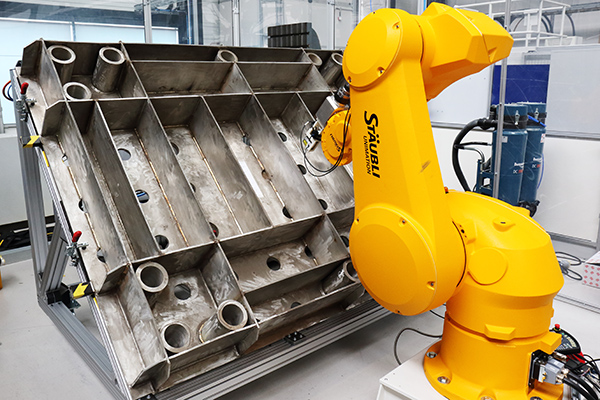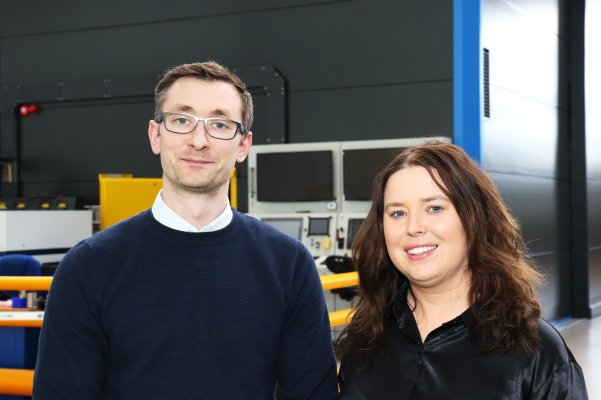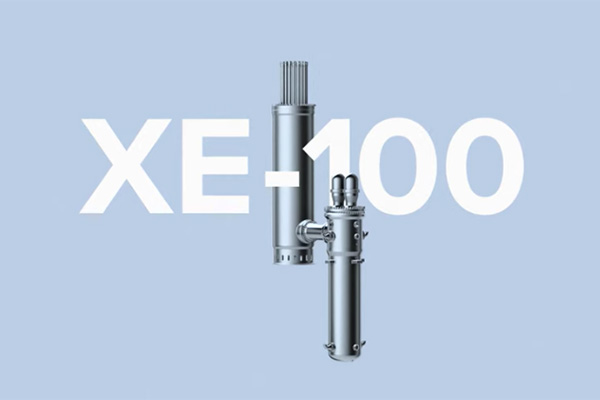Nuclear AMRC engineers have successfully demonstrated automated grinding techniques for nuclear components, as part of a European collaboration to develop intelligent robot technologies.
The centre’s robotic and metrology engineers developed automated techniques for grinding out welds on a nuclear fuel rack base, and for deburring tube structures, using a variety of technologies developed through the Coroma project.
 The three-year Coroma project brought together companies and research institutions from across Europe to develop cognitively-enhanced modular industrial robots which can perform a range of manufacturing tasks with minimal input from human operators. The applications developed by the Nuclear AMRC team were identified by one of the industrial partners, Spanish nuclear manufacturer Ensa, as a test of the Coroma technologies in a real workshop environment.
The three-year Coroma project brought together companies and research institutions from across Europe to develop cognitively-enhanced modular industrial robots which can perform a range of manufacturing tasks with minimal input from human operators. The applications developed by the Nuclear AMRC team were identified by one of the industrial partners, Spanish nuclear manufacturer Ensa, as a test of the Coroma technologies in a real workshop environment.
Weld grinding of the fuel rack base is currently done manually, a task taking around 80 hours, with prolonged use of hand-held grinders putting operators’ health at risk from harmful vibrations. Ensa’s challenge to the Coroma consortium was to automate the process to minimise human involvement.
The Nuclear AMRC team developed a full-scale technology demonstrator, integrating a variety of innovative digital manufacturing technologies developed by the other Coroma partners integrated with a large Staübli robotic arm. These technologies include visual scanning and analysis to map where grinding is required – a challenging task when the actual fabrication doesn’t precisely match the CAD model. The Coroma partners developed a novel scanning technology which could also be deployed for processes such as welding and additive manufacturing.
Other innovations include optimisation software to determine the most efficient way to remove the excess material, and location monitoring techniques to ensure the robot remains correctly and accurately positioned relative to the workpiece.
All of these physical and digital technologies had to be integrated into a single system. “You have lots of different hardware and software trying to talk to each other,” explains research engineer Ozan Gurdal. “What we wanted to develop was a versatile, flexible system so that you can do the integration with one click.”
The team were also challenged to deliver a cost-effective solution which will make economic sense for smaller businesses.
“What’s making it cost-effective is the engineering effort we put in,” Gurdal says. “It’s important that it’s robot independent – if you take the end effector out and put it on another robot, it’s a one-click integration. That gives you the ability to use it in different environments.”
Compared with conventional robot programming, the Coroma approach demonstrated time savings of more than 70 per cent for each pocket in the rack base – saving more than 40 hours for the complete assembly.
 The second industrial use case developed by the Nuclear AMRC involved deburring of metal matrix composite tubes used in nuclear fuel assemblies. The current process takes around 85 minutes on a machine tool, followed by four hours of manual grinding.
The second industrial use case developed by the Nuclear AMRC involved deburring of metal matrix composite tubes used in nuclear fuel assemblies. The current process takes around 85 minutes on a machine tool, followed by four hours of manual grinding.
Using a robot avoids the cost of an expensive machine tool while matching its quality, and also minimises risks to human operators. Exploiting the Coroma scanning and analysis techniques also allowed the team to streamline the process. “We completely eliminated the CAM stage, so the robot can work straight from the scan data,” Gurdal notes.
A third nuclear industry demonstrator, led by Spanish research group IK4–Ideko and the UK’s Shadow Robot Company, focused on automated ultrasonic inspection of steam generator nozzles for fault detection.
The Nuclear AMRC also worked with its sister centre, the University of Sheffield AMRC, to integrate a small robot arm onto its large Soraluce machine tool platform. The arm provides intelligent support for thin-walled parts during machining, successfully demonstrating collaborative working between the two technologies.
While all the technologies will require further development before they can be commercialised, the Coroma consortium are now looking to connect with manufacturers who are interested in putting them into production.
The €6 million Coroma project ran from 2016–19 and was funded through the European Horizon 2020 programme. The Coroma consortium includes 16 international partners from seven countries, led by IK4–Ideko.
For more information, email ozan.gurdal@namrc.co.uk




